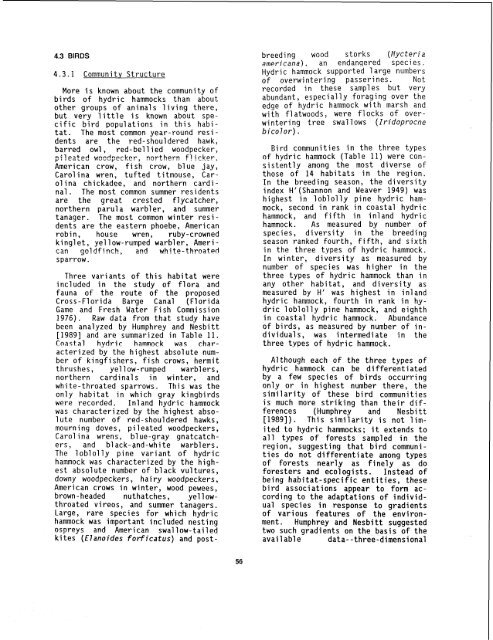The Ecology of Hydric Hammocks - USGS National Wetlands ...
The Ecology of Hydric Hammocks - USGS National Wetlands ...
The Ecology of Hydric Hammocks - USGS National Wetlands ...
Create successful ePaper yourself
Turn your PDF publications into a flip-book with our unique Google optimized e-Paper software.
4.3 BIRDS4.3.1 Community StructureMore is known about the community <strong>of</strong>birds <strong>of</strong> hydric hammocks than aboutother groups <strong>of</strong> animals 1 iving there,but very little is known about specificbird populations in this habitat.<strong>The</strong> most common year-round resi -dents are the red-shouldered hawk,barred owl , red- be1 1 ied woodpecker,pifeated uoc~~ecker, northern f! ic4er,American crow, fish crow, blue jay,Carol ina wren, tufted ti tmouse, Carolinachickadee, and northern cardinal.<strong>The</strong> most common summer residentsare the great crested flycatcher,northern parul a warbler, and summertanager. <strong>The</strong> most common winter residentsare the eastern phoebe, Americanrobin, house wren, ruby-crownedking1 et, ye1 1 ow-rumped warbler, Ameri -can galdf inch, and whi te-throatedsparrow.Three variants <strong>of</strong> this habitat wereincluded in the study <strong>of</strong> flora andfauna <strong>of</strong> the route <strong>of</strong> the proposedCross-Florida Barge Canal (FloridaGame and Fresh Water Fish Commission1976). Raw data from that study havebeen analyzed by Humphrey and Nesbitt[1989] and are summarized in Table 11.rnastal hydric hammock wat characterizedby the highest absolute number<strong>of</strong> kingfishers, fish crows, hermitthrushes, ye1 low-rumped warblers,northern cardinals in winter, andwhite-throated sparrows. This was theonly habitat in which gray kingbirdswere recorded. In1 and hydric hammockwas characterized by the highest absolutenumber <strong>of</strong> red-shouldered hawks,mourning doves, pileated woodpeckers,Carol ina wrens, bl ue-gray gnatcatchers,and black-and-white warblers.<strong>The</strong> loblolly pine variant <strong>of</strong> hydrichammock was characterized by the highestabsolute number <strong>of</strong> black vultures,downy woodpeckers, hairy woodpeckers,American crows in winter, wood pewees,brown-headed nuthatches, yellowthroatedvireos, and summer tanagers.Large, rare species for which hydrichammock was important included nestingospreys and American swallow-tailedkites (Elanoides forficatus) and post-breeding wood storks (Rycteriaamericana). an endanqered species.<strong>Hydric</strong> hammock supported large numbers<strong>of</strong> overwintering passeri nes. Notrecorded in these samples but veryabundant, especi a1 ly foraging over theedge <strong>of</strong> hydric hammock with marsh andwith fl atwoods, were flocks <strong>of</strong> overwinteringtree swal 1 ows (Iridoprocnebicolor).Bird communities in the three types<strong>of</strong> hydric hammock (Table 11) were consistentlyamong the most diverse <strong>of</strong>those <strong>of</strong> 14 habitats in the region.In the breeding season, the diversityindex H1(Shannon and Weaver 1949) washighest in loblolly pine hydric hammock,second in rank in coastal hydrichammock, and fifth in inland hydrichammock. As measured by number <strong>of</strong>species, diversity in the breedingseason ranked fourth, fifth, and sixthin the three types <strong>of</strong> hydric hammock.In winter, diversity as measured bynumber <strong>of</strong> species was higher in thethree types <strong>of</strong> hydric hammock than inany other habitat, and diversity asmeasured by H' was highest in inlandhydric hammock, fourth in rank in hydricloblolly pine hammock, and eighthin coastal hydric hammock. Abundance<strong>of</strong> birds, as measured by number <strong>of</strong> individuals,was intermediate in thethree types <strong>of</strong> hydric hammock.A1 though each <strong>of</strong> the three types <strong>of</strong>hydric hammock can be differentiatedby a few species <strong>of</strong> birds occurringonly or in highest number there, thesimilarity <strong>of</strong> these bird communitiesis much more striking than their differences(Humphrey and Nesbi tt[1989]). This similarity is not limitedto hydric hammocks; it extends toall types <strong>of</strong> forests sampled in theregion, suggesting that bird communi -ties do not differentiate among types<strong>of</strong> forests nearly as finely as d<strong>of</strong>oresters and ecologists. Instead <strong>of</strong>being habitat-specific entities, thesebird associations appear to form accordingto the adaptations <strong>of</strong> individualspecies in response to gradients<strong>of</strong> various features <strong>of</strong> the environment.Humphrey and Nesbi tt suggestedtwo such gradients on the basis <strong>of</strong> theavai 1 able data--three-dimensional

















